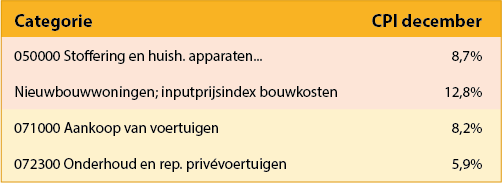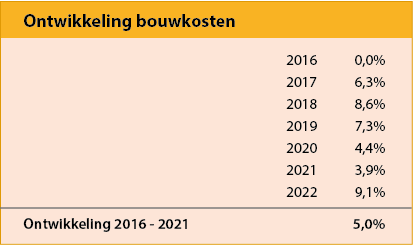To inflate or not to inflate, that is the next question?
Melchior Mattens MSc AAG
melchior.mattens@arcturus.nl
Since March 2022, inflation in the Netherlands has been rising enormously as a result of increasing energy prices due to the war in Ukraine. For example, in its September forecast, the CPB expects [1]inflation (Consumer Price Index, hereinafter CPI) to amount to 9.9% in 2022 and to fall to 2.6% in 2023. In December, DNB issued a more alarming forecast: in 2023 and 2024, the HIPC (Harmonized Consumer Price Index) would end up at 4.9% and 5.0%, provided the energy prices drop sharply [2]. According to DNB, core inflation (excluding energy and food) will be 4.8% and 2.8% in 2023 and 2024. For 2022, the CBS estimates a realized CPI of 9.6%.
Because inflation is exceptionally high in 2022 and inflation may also remain extremely high in the coming years, the question quickly arises which inflation figures are now relevant for the valuation of the technical provisions and how a non-life insurer should incorporate inflation in the technical provisions? As a follow-up from our earlier article on inflation, we will take a closer look at this in this article.

Melchior Mattens MSc AAG
melchior.mattens@arcturus.nl
Inflation
Inflation for a non-life insurer often deviates from the consumer price index (CPI). This is because insurance claims often have their own inflation pattern. Think of personal injury claims, where additions to the WAM (Dutch Motor Vehicle Liability Legislation), such as affection claims, have led to a completely different inflation pattern than the CPI. But building materials or car parts also have very different inflation rates than the CPI. In addition, an insurance portfolio for motor vehicles is affected by the fact that in recent years cars have received more and more integrated technology, as a result of which making repairs have become much more expensive.
The CBS [1]provides insight into the current state of the CPI. The CPI drops sharply from 14.3% in October to 9.6% in December. This indicates that the projection of the CPB from September for the whole of 2022 was a realistic estimate. In addition, the CBS provides insight into the various product categories and their contribution to the CPI. For December, it appears that more than 3 percentage points of the 9.6% CPI, are caused by inflation in energy, i.e., the price increase of other products and services accounts for 6.6 percentage points of inflation. The change in the CPI in December, compared to October, is almost exclusively due to a fall in energy prices.
As a yardstick for the future claims costs, as used in the premium setting of insurers, the historical claim costs and the observed inflation play an important role. However, the impact of inflation depends on the risk profile of the product. It is therefore important to look at which component is influencing: price, wage and/or product inflation. As a result of the projected increase in inflation, non-life insurance premiums can be expected to increase as well as management costs, in particular as a result of wage developments.
Based on the data currently available with regard to the development of inflation, it can therefore be expected that the total claim costs will increase in the next two years, depending on the inflation forecast used. It is advisable to translate this into a surcharge that is included in the premium setting, while also taking into account the increasing claim costs for reinsurance and thus the price of reinsurance cover to be purchased. In view of the development in the level of inflation and the uncertainty surrounding the forecast, it is recommended to consider a number of scenarios (sensitivity analysis).
The December CPI can be broken down into deeper product categories relevant to the insurance industry. For example, the material component of new-build homes in terms of price index [1]was 12.8% higher in November than a year earlier. The table below provides a breakdown of relevant cost developments for home and contents insurance and for Motor Liability and Casco insurance.

For the Motor Liability portfolio, a combined inflation must be taken into account, whereby for material claims (as for Motor Casco) an average inflation of new car purchases as well as vehicle repairs can be assumed. For personal injury claims, the CPI excluding energy is rather [1]obvious, because this compensation consists of a mixture of loss of working capacity (VAV) and reimbursement of other costs. The VAV in particular will be adjusted in the medium term towards the realized CPI excl. energy (assuming that wages in the longer term will be corrected for the high inflation in 2022), and given that this represents a large part of the incurred loss, this gives a substantiation for assuming the CPI excluding energy for this purpose.
In order to arrive at a general inflation figure for this Line of Business (LoB), a weighting between material claim and personal injury must therefore be determined. We can deduce this from the statistics in various ways:
- When an insurer has information about the historical relationship of incurred losses between injury and material claims, this historical relationship can be used. If data is available for this, it is wise to investigate whether there are trends in the frequency of claims for both personal injury and material claims, as well as for the average claim amounts.
If possible: correct for these trends to obtain a best estimate for the weighting between injury and material claims for the year 2023. - When the data quality does not allow for a historical weighting in one's own portfolio, public data can be used, among other things, to make a historical weighting between injuries and properties. From the STAR accident registration, we know that for the whole of the Netherlands in 2022, approximately 90,000 accidents have occurred by December 1. Of these, 20,000 involved injuries [2]. If we assume that the relationship between material and personal injuries is approximately the same for one-vehicle and two-vehicle accidents, then 22.2% personal injury claims could be assumed in determining the weighting factors. In order to arrive at a relationship of incurred losses between injury and material claims, an approximation must also be found for the average amount of claims to which we can apply this frequency weighting. For this purpose, the available data of minor and major claims for Motor Liability could be looked at. Practical experience shows that major claims almost always have an injury component and minor claims almost never have it. If a personal injury claim does not exceed a few thousand euros [3], then this usually does not deviate significantly from material claims in terms of inflation development, because it often concerns reimbursement of healthcare costs or temporary support.
[1] Raming Macro Economische Verkenning 2023 (MEV) - cpb.nl
[2] Economie koelt af, inflatie blijft hoog - dnb.nl
[3] Dashboard consumentenprijzen - cbs.nl
[4] StatLine - Nieuwbouwwoningen; inputprijsindex bouwkosten 2015=100 - cbs.nl
[5] We advise the CPI excluding energy because we currently see energy prices falling and are very volatile. Wages seem to be corrected for structural inflation (not energy-related), in which the temporary high energy prices are often compensated by one-off payments from employers. See also the wage cost projection of the CPB.
[6] STAR: Smart Traffic Accident Reporting (star-verkeersongevallen.nl)
[7] Choosing an adequate threshold can be done on the basis of a rule of thumb that personal injury claims with a significant VAV and/or domestic help component can never, as a rule, have an incurred loss of less than 50,000 euros (ie at least 25% loss of work capacity based on full-time minimum wage). (12 x 1,934 euros) for 5 years already leads to an incurred loss of 29,000 euros for the VAV component alone). It is also customary to use a higher threshold than 50,000 euros.
For other branches such as Personal Liability / Corporate Liability, Travel Insurance or Legal Assistance, we see that a mixture of items can be reimbursed from this. It includes both a wage cost aspect and reimbursement of various material claims. Therefore, for such industries, the use of the CPI (excl. energy) for 2022 is justified in our view.
Operating costs are also rising due to inflation. We can assume that these largely consist of personnel costs. These costs are directly linked to the Collective Labor Agreement (Dutch: CAO) for the insurance industry. A best estimate for wage development in 2022 and 2023 is the CPB projection for the CAO-wages of companies, which will amount to 2.9% in 2022 and 3.7% for 2023. DNB estimates that wages will rise by 5% and 4.2% in 2023 and 2024. Due to the great uncertainty, we see DNB's more conservative estimate as a sensible starting point for the valuation of technical provisions at year-end 2022.
The discussed principles lead to an overview of the proposed inflation percentages to be used per sector and for the costs at the year-end of 2022. Are we there then? Not yet, because we are actually looking for the 'additional inflation over 2022'. After all, the long-term inflation trend has already been implicitly incorporated in the modeling of the technical provisions, because it is included in the historical claim figures. This generally applies to both the claims provision and the premium provision, because implicit inflation is not only incorporated in many common models for the claims provision (such as the Chain-Ladder), but also in the determination of the premium provision. The latter one happens because the premium base is regularly indexed by many insurers, to which the long-term ratios are then applied.
To determine the additional inflation, one option is to assume the long-term inflation trend to be equal to the ECB's aim of keeping inflation at 2.0% on average over the long term. However, it is better to use historical claims inflation analysis to find out whether Line of Business-specific inflation deviates significantly from this 2% and to replace this ECB target with it. By deducting the LoB-specific long-term inflation from the figures for 2022, we get an additional inflation figure per LoB for 2022, which can be used in the modeling of the technical provisions.
An example
For home insurance, long-term inflation can be derived from CBS figures on the output price index for construction costs for new homes (see table below). Over the period 2016-2021, average inflation has been 5%. This could be used as a starting point to compare the inflation figures for 2022 (and thus the determination for the additional inflation for home insurance policies).

Solvency II Technical Provisions
Below we discuss how inflation in the claim and premium provisions can be incorporated under Solvency II for non-life insurers. The impact on income protection insurance portfolios is not considered.
Claim provision
Non-life insurers using the Chain-Ladder modeling have to deal with the implicit model assumption that there will be an approximately constant inflation trend per calendar year in the incurred losses over the long term. For 2022 there is a clear deviation from this assumption. We also consider it wise to consider the higher expectations of DNB compared to the CPB for the following years, because there is great uncertainty in the development of inflation. However, the development of the incurred losses should be based on core inflation, because for the vast majority of the non-life portfolio, material claims are covered and the volatility in energy prices (which are currently falling sharply again) may not be consistent with the price development of insured claims.
This means that a correction must be applied to the expected outgoing cash flows for the future years by means of an inflation curve. In this case, the outgoing cash flow in 2023 is corrected with the additional inflation for 2022 and half of the additional inflation for 2023 (six months delay). The cash flow in 2024 will continue to be cumulative with a 50%-50% weighting of the additional inflation for 2023 and 2024, and the cash flow for 2025 will get 50% of the additional inflation for 2024. All cash flows after 2025 will be increased by the same cumulative inflation factor. Because core inflation will again be close to 2% in 2024, according to the DNB, we assume that no further adjustment for additional inflation will be necessary after this horizon.
There seems to be no reason to assume that the payment patterns of the claims reserve also change significantly due to inflation. It is important, however, to monitor for each sector the impact of higher payments on the estimated duration of the settlement of provisions. An adjustment can be made for this purpose in special cases on the basis of expert judgement. The uncertainty this yields, makes it important to (continue to) backtest sufficiently on the difference between the estimate and realization.
The provision for claims handling costs also uses an implied cost inflation component. The adjustment for 2022 can be made by increasing the expected cost amount per year by the additional cost inflation for each outstanding claim. For this purpose, the expected development of the CAO-wages by DNB can be applied (5% on the cost cash flow for 2023 and 9.4% (cumulation of 5% in 2023 and 4.2% in 2024) for 2024 and beyond).
Premium provision
The expected claims ratio, the cost ratio, the reinsured claims , the expected cancellation and the settlement pattern of the incurred losses play a role in the premium provision.
It is important for the premium provision that the Combined Ratio (COR) is adequately adjusted to the inflation expectation. For example, the expected future claims ratio can be determined on the basis of a long-term average of the (annual) claims ratios, taking into account historical inflation and premium adjustments (general inflation correction method). However, at the end of 2022, two things must be taken into account:
- The additional inflation over 2022, 2023 and 2024, which cumulatively increases the claims ratio;
- Adjusted premium rates to correct for inflation, which lowers the claims ratio.
By correcting the premium and claims basis for both effects, a pure estimate of the claims ratio is obtained. The first effect should be determined by weighting the additional inflation using the payment patterns. For multi-year contracts, the applied claims ratios can be adjusted by the same factor. As for the claims provision, it is assumed that core inflation will drop to the long-term average of 2% after 2024, which means that there will probably no longer be any significantly higher technical-claim inflation.
The same considerations apply to the expense ratio, but a different inflation correction is applied to the costs than is applied to the incurred losses, namely with the 5% expected increase in wage costs in 2023. For reinsurance, the inflation adjustments in the reinsurance premium and commission are incorporated in contractual percentages. For the reinsured incurred losses in the premium provision, the reinsured claims ratio continues to be determined on the basis of the gross claims ratio multiplied by the quota share percentage and on the basis of long-term Excess of Loss income (corrected for historically adjusted Quota Share percentages and deductibles) . This ratio relates the reinsured incurred losses to the gross incurred losses. The gross incurred losses have been adequately adjusted for the inflation-expectation, on the basis of the stated method, which means that the reinsured incurred losses have also been sufficiently adjusted automatically.
The economic conditions not only lead to high inflation, but may also lead to higher cancellations in times of recession. In valuing the premium provision at year-end 2022, it may be too prudent to anticipate uncertainty surrounding economic developments and their impact on cancellations. This underlines the importance for non-life insurers to conduct an extensive sensitivity analysis of their assumptions regarding cancellation.
As for the claims provision, a temporarily higher inflation may have an impact on the run-out pattern of the premium provision. As with the claims provision, there seems to be no reason to adjust this pattern, but if it is done on the basis of expert judgement, then it is advisable to also adopt this in the premium provision.
